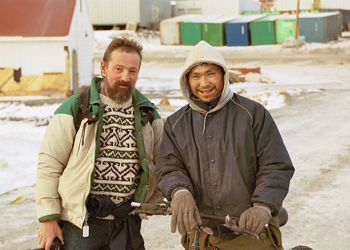Gabriel Warren
MOST importantly, I consider myself a landscape sculptor– by which I do not mean that I bounce about on bulldozers: there are scars enough on the land. Rather, the forms and patterns that I find in my travels, especially in ice, give me an armature for my intellectual, emotional, visual explorations and probings in metal, as well as glass, stone, and other materials. These emerge from my deep appreciation of the natural world, and my distress at the insults, many of them irrevocable, that it receives from our species. This environmental subtext is not presented in an obviously illustrative kind of way, but woven into a metaphorical fabric.
In the quest for authenticity and vocabulary in my sculptural voice, I travel extensively. In 1999, I became the first sculptor from any country to be sent to Antarctica, courtesy of the National Science Foundation and the Rhode Island State Council on the Arts. I lived primarily on the largest non-nuclear icebreaker in the world, the USCG Polar Sea, and spent numerous hours observing from her helicopters. In autumn 2001 I spent five weeks on Canada’s largest icebreaker, the ‘Louis S. St-Laurent’, in the Lancaster Sound area of the high Arctic, which also involved numerous helo flights over land, sea, and ice. This trip was made possible by a grant from the Rhode Island Foundation. In 2006 I returned to ‘The Ice’ (Antarctica), again courtesy of the National Science Foundation. This trip earned me the Antarctic Service Medal. Activities during this trip included descents into crevasses, flying to Pole as ‘cockpit observer’ (and photographer) in an LC-130 military transport plane, a residency with a glaciology science team in the Dry Valleys, and yet more helo photo flights. As well, in 2014 I was a member of the “Dark Snow” team from GEUS (Geological Survey of Denmark and Greenland) researching climate change in the ablation zone– the “lake district”– on the Greenland Ice Cap for the two weeks of the last rotation of the season. Other trips to nourish my work have included New Zealand (five times), Alaska tidewater glaciers, Scotland (twice), Central America (thrice), central Sahara Desert, American Southwest (thrice), Egypt, and others. Photography from some of these trips appears in the Sources section, and is the genesis for works on paper.
Background image: Drone image of ablation belt of the Greenland ice cap.












